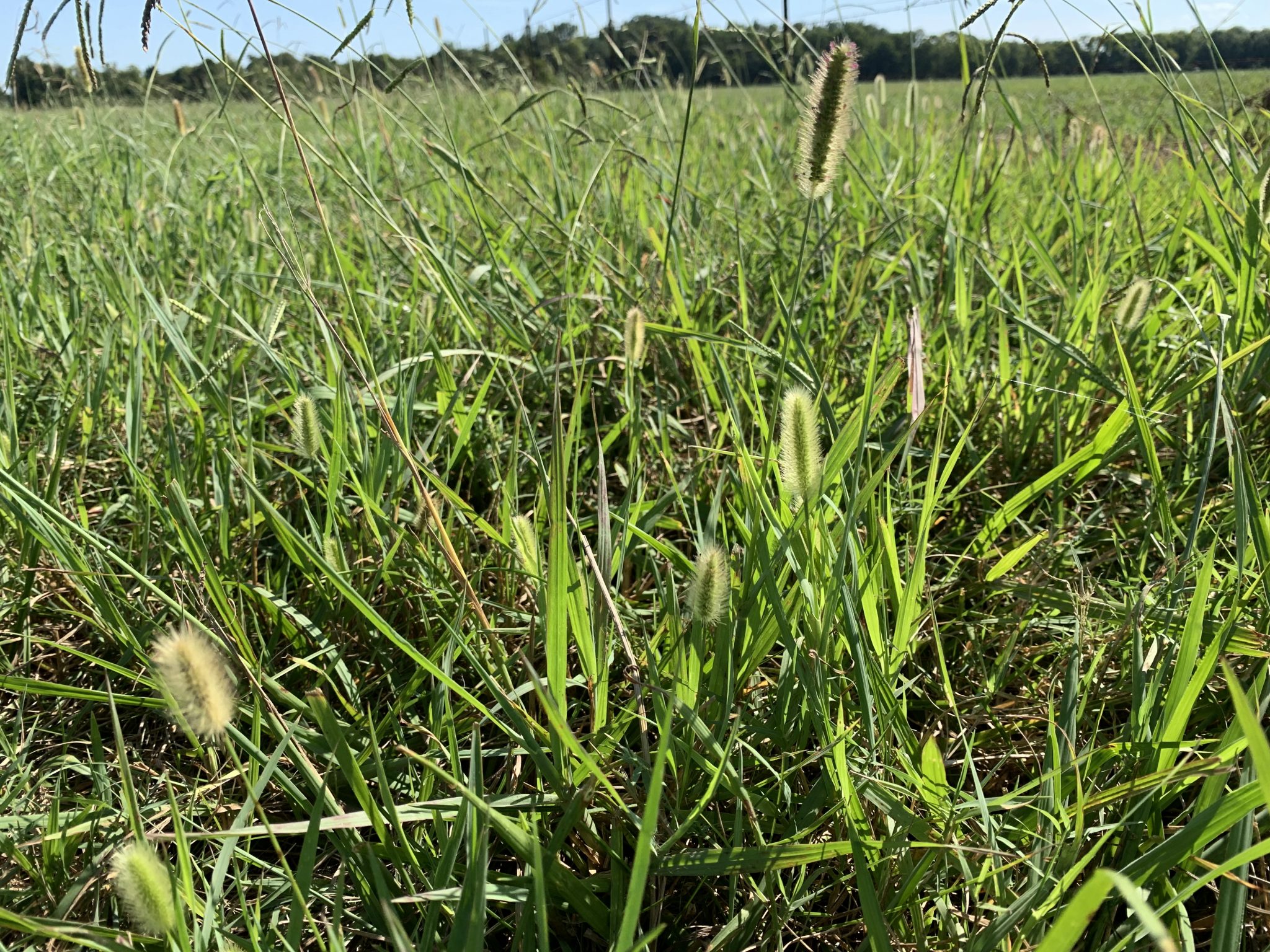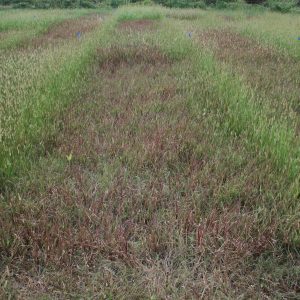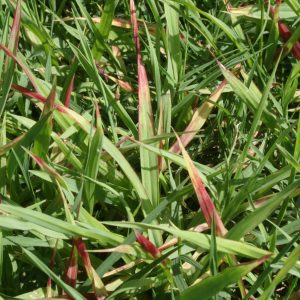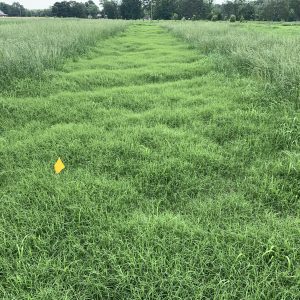Forages

As day length shortens and weed seed matures, the balance between weed control and quality forage production becomes increasingly difficult.
Foxtail Species in Alabama
Four foxtail species may be found in Alabama: green (Setaria virids), giant (Setaria faberi), yellow (Setaria pumila), and knotroot (Setaria parviflora). Arguably, the two most common species are yellow and knotroot or marsh bristlegrass. Yellow foxtail is an annual and the knotroot perennial. Both have relatively good forage quality when plants are young but decline as the season progresses. As plants mature and seedheads form, foxtail becomes undesirable and is often difficult to control. Integrated management strategies that utilize a combination of cultural, mechanical, and chemical control methods are usually more effective on foxtail species than single methods alone. Fortunately, there are a few herbicide options that have shown activity on this problematic weed.
Chemical Control for Foxtail
Postemergence Options
Pastora (nicosulfuron + metsulfuron): The longstanding recommendation for foxtail control in southeastern bermudagrass forage has been 1.5 oz/A (per acre) Pastora + 8 floz/A Roundup (4 lb formulation), followed by 1 oz/A Pastora 14 days later (Fig. 1). Even with ideal growing conditions, this application has almost always stunted bermudagrass forage, and in many cases, growers have lost a hay harvest. Approximately 70 percent foxtail control is the extent of this treatment at one to two months after application if the treatment is made before seedhead formation. Applications of 1.5 oz/A of Pastora alone has been helpful in providing some suppression when applied to young and actively growing foxtail (before seedhead emergence). Do not apply to bahiagrass or tall fescue. There are no grazing or haying restrictions for livestock.
Facet L (quinclorac): Seasonal control with Facet L is similar to Pastora, but with much less bermudagrass and tall fescue injury. Use rates are 12 – 64 floz/A. Using 16 floz on 3-inch-tall knotroot foxtail will provide about 3-4 weeks suppression (Fig. 2). 1 qt/A has provided 60-70 percent control for about three months and 2 qts/A has provided 75-80 percent control for three months. Risk of injury to desirable forage increases with broadcast rate. Vigorous bermudagrass growth and forage cover has provided competition and increased the level of foxtail control. Include a methylated seed oil at 1 % v/v solution with all Facet L postemergence applications. There is a 7-day haying restriction, but no grazing restrictions.
Plateau, Impose, or Panoramic (imazapic): Foxtail control with imazapic products is nearly equivalent to the higher rates of Pastora. Field trials have shown 8-12 floz/A provides >70 percent control for at least four to six weeks, however bermudagrass stunting is likely. In many cases at least one hay harvest may be lost from in-season applications. Do not use on bahiagrass and tall fescue. There is a seven-day restriction for hay harvest.
- Figure 1. 1.5 oz Pastora + 8 floz Roundup, followed by 1 oz Pastora 14 days after initial application. Photo taken 26 days after initial application.
- Figure 2. Knotroot foxtail showing herbicide symptoms from 1 qt/A Facet L + 1% v/v MSO. Photo taken 14 days after treatment (DAT).
- Figure 3. 2 qt/A Velpar L was applied April 1 on emerging bermudagrass. Photo taken June 2 (2 months after treatment). Bermudagrass was stunted for 2-3 weeks but control of foxtail and crabgrass remain above 80% percent. Seedling annual ryegrass was controlled 100 percent.
Velpar L (hexazinone): This product is most likely known for its use for smutgrass control in bahiagrass forages. Velpar has both foliar and soil activity. Typical use rates are 44 – 72 floz/A on established stands of bermudagrass and bahiagrass. Sprayer output of at least 20-25 GPA is recommended for broadcast applications. Recent field trials indicated early spring applications of 1 qt/A Velpar has provided 75-80 percent foxtail and crabgrass control for at least three months and 2 qts/A has provided 85-90 percent control for three months (Fig. 3). Healthy forage growth and ground cover competition has increased the level of control. Severe bermudagrass suppression and/or discoloration is likely with higher rates. Adding a surfactant is not recommended. Do not use on tall fescue. Velpar has no grazing restriction but does have a 38-day haying restriction. Do not use within 100 feet of desirable trees or where surface water runoff may lead toward trees. Lower use rates are recommended for coarse-textured soils and higher rates are recommended for fine-textured soils and soils high in organic matter.
Preemergence Options
Prowl H20 (pendimethalin): Prowl H2O may be applied on established bermudagrass, bahiagrass, or tall fescue. Growers may use a split application of 2.1 qts/A, followed by 2.1 qts/A approximately three to six weeks apart, or the full amount of 4.2 qts/A prior to weed seed germination. If growers plan to use the split application, the initial treatment should be made during late winter prior to greenup. Do not apply during, or immediately after spring greenup because pendimethalin will prevent young bermudagrass and bahiagrass plants from rooting and spreading. Rainfall is absolutely necessary following an application for soil incorporation. Prowl H2O has no preharvest or pre-grazing restrictions when applied on established forage grasses.
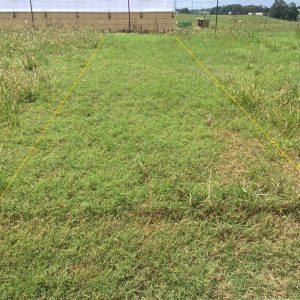
Figure 4. 2.5 floz Rezilon controlling yellow foxtail 167 days after treatment (DAT) in bermudagrass pasture.
Rezilon (indaziflam): This product received registration in Alabama in 2021 and is labeled for use in established bermudagrass and bahiagrass forages. Use in tall fescue is not permitted. When compared to Prowl H2O, Rezilon has generally provided longer control of most cool and warm season annual grasses and small-seeded broadleaf weeds (Fig. 4). When targeting annual foxtail, growers may make a split application of 3 floz/A in February (prior to weed seed germination), and another 3 floz/A following the first hay cutting, or a one-time 5 floz/A application in February. Applications should not exceed 6 floz in a 12-month period. A 40-day haying restriction will apply for any single application that exceeds 3 floz/A. There are no grazing restrictions.
Final Thoughts for Late-Season Foxtail
Unfortunately, none of the herbicide options presented here will completely remove foxtail from fields late in the season. Some of the postemergence treatments may provide suppression, however, and could inhibit some seed from reaching maturity. Seed production can be minimized by livestock grazing pressure and mowing frequency. Be sure to keep these foxtail populations in mind in order to provide proactive weed management strategies, as new plants are likely to return in the coming seasons.
Trade names are used only to give specific information. The Alabama Cooperative Extension System does not endorse or guarantee any product and does not recommend one product instead of another that might be similar.

